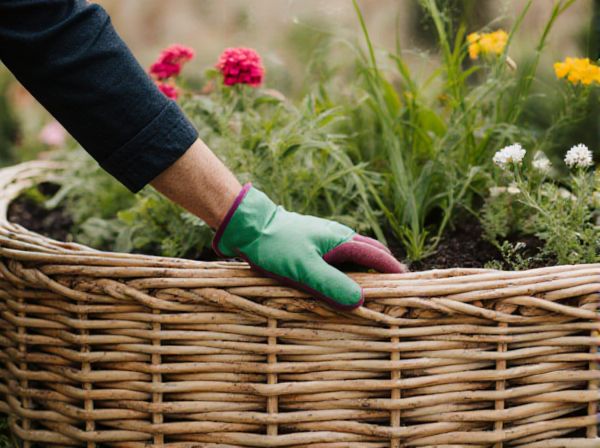
Wicking beds vs standard planters Illustration
Wicking beds offer a self-watering system that efficiently conserves water while promoting deep root growth, unlike standard planters that often require frequent manual watering and can lead to inconsistent moisture levels. The sub-irrigation in wicking beds reduces water evaporation and runoff, making them ideal for dry climates and sustainable gardening practices. Standard planters tend to dry out quickly and may stress plants, whereas wicking beds maintain optimal hydration, improving plant health and yield.
Table of Comparison
| Feature | Wicking Beds | Standard Planters |
|---|---|---|
| Water Efficiency | High - self-watering via capillary action | Low - requires frequent surface watering |
| Maintenance | Low - retains moisture, reduces watering frequency | High - needs regular watering and monitoring |
| Plant Health | Improved - consistent moisture levels reduce stress | Variable - risk of over or underwatering |
| Cost | Moderate - initial build cost higher | Low - simple and affordable |
| Suitability | Best for water-scarce climates and deep-rooted plants | Suitable for general gardening and shallow-rooted plants |
| Soil Health | Enhanced by reduced runoff and nutrient retention | Prone to nutrient leaching and erosion |
Understanding Wicking Beds: A Permaculture Perspective
Wicking beds utilize a self-watering system that draws water from a reservoir beneath the soil, promoting efficient moisture retention ideal for permaculture environments. These beds reduce water waste and enhance root health by maintaining consistent soil hydration, unlike standard planters that often rely on surface watering and experience rapid drying. Incorporating wicking beds supports sustainable gardening by optimizing water use and encouraging resilient plant growth within permaculture designs.
Standard Planters: Traditional Gardening Explained
Standard planters in traditional gardening provide controlled environments for plant growth, allowing for easy soil management and root aeration. They often require more frequent watering compared to wicking beds, as water does not circulate from a reservoir below, leading to potential water stress in plants. Soil quality, drainage, and container size are critical factors influencing plant health in standard planters, making them suitable for diverse gardening conditions but demand consistent maintenance.
Water Efficiency: Wicking Beds vs Standard Planters
Wicking beds significantly improve water efficiency by delivering moisture directly to plant roots through a self-watering reservoir system, reducing evaporation and runoff compared to standard planters. These beds enable consistent soil moisture levels, which promotes healthier plant growth with less frequent watering. Standard planters often lose water through surface evaporation and drainage, making wicking beds a superior choice for sustainable water usage in permaculture gardening.
Soil Health and Microbial Life in Both Systems
Wicking beds enhance soil health by maintaining consistent moisture levels, promoting a diverse and active microbial ecosystem essential for nutrient cycling and plant growth. Compared to standard planters, wicking beds reduce waterlogging and aerate the soil more effectively, fostering beneficial aerobic microbes while suppressing harmful pathogens. This stable environment in wicking beds supports stronger root development and improved soil structure, boosting long-term fertility crucial for sustainable permaculture practices.
Productivity and Plant Growth Comparison
Wicking beds consistently outperform standard planters in productivity by providing a self-watering system that ensures optimal moisture levels for plant roots, reducing water stress and promoting faster, healthier growth. The capillary action in wicking beds delivers water directly to the root zone, minimizing evaporation and nutrient washout, resulting in higher yields and more vigorous plants. In permaculture, leveraging wicking beds can maximize space efficiency and resource use, making them ideal for sustainable, high-productivity gardening.
Maintenance Demands: Which System is Easier?
Wicking beds require less frequent watering due to their self-watering design, which reduces maintenance demands compared to standard planters. Standard planters often need daily monitoring and manual watering, increasing time and effort spent on upkeep. The integrated water reservoir in wicking beds promotes consistent moisture levels, making them easier to manage, especially in drought-prone or busy gardening situations.
Suitability for Urban and Rural Permaculture
Wicking beds excel in urban permaculture by efficiently conserving water and maximizing limited space through self-watering systems, which helps sustain healthy plant growth with minimal maintenance. Standard planters, while versatile and easier to move, often rely on frequent watering and may not retain moisture as effectively, making them less suitable for water-conscious rural settings. In rural permaculture, integrating wicking beds can improve water use efficiency and soil health, enhancing both small-scale food production and ecological sustainability.
Cost Analysis: Installation and Long-term Savings
Wicking beds typically involve higher initial installation costs due to materials like liner, wicking medium, and irrigation setup compared to standard planters made of basic soil and containers. Over time, wicking beds offer significant long-term savings by reducing water usage by up to 50%, minimizing the need for frequent watering and lowering utility bills. Standard planters often require more frequent watering and soil replenishment, increasing ongoing maintenance expenses.
Sustainability and Environmental Impact
Wicking beds significantly reduce water consumption by delivering moisture directly to plant roots, enhancing water-use efficiency compared to standard planters. These self-watering systems minimize runoff and evaporation, promoting sustainable gardening practices with lower environmental impact. By conserving water and reducing the need for frequent irrigation, wicking beds support permaculture goals of resource conservation and ecosystem health.
Choosing the Right System for Your Permaculture Garden
Wicking beds offer a self-watering system that conserves water and reduces maintenance, making them ideal for sustainable permaculture gardens in arid or drought-prone regions. Standard planters provide greater flexibility in soil choice and plant variety but require more frequent watering and monitoring, which may increase labor input. Selecting between wicking beds and standard planters depends on water availability, crop selection, and desired labor investment for optimal permaculture design.
Wicking beds vs standard planters Infographic

 gardendif.com
gardendif.com